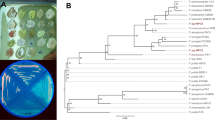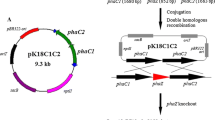Abstract
Pseudomonas stutzeri strain 1317 was found to grow on various fatty acids, alcohols, diols, as well as glucose and gluconate for the synthesis of polyhydroxyalkanoates (PHA) with various monomer units. The PHA monomer structures were dependent on the type of fatty acids and alcohols, as well as the diols in the culture media. Only even number monomers, such as 3-hydroxyhexanoate (HHx), 3-hydroxyoctanoate (HO) and 3-hydroxydecanoate (HD), were accumulated when even numbered fatty acids, alcohols, glucose and gluconate, as well as diol were used as carbon sources. Odd numbered fatty acids and odd numbered alcohols led to the formation of odd numbered monomers, such as 3-hydroxyvalerate (HV), 3-hydroxyheptanoate (HHp), 3-hydroxynonanoate (HN) and 3-hydroxyundecanoate (HU). The strain tolerated up to 1.5% of ethanol and made 8.3% of PHA when growth was conducted in 1.2% of ethanol. PHA formed up to 77% of cell dry weight when the strain was grown in tridecanoate. PHA synthesis was highly dependent on the nitrogen source. A depletion in nitrogen supply immediately resulted in PHA accumulation in cells grown in the glucose mineral medium.
Similar content being viewed by others
References
Abe H & Doi Y (1994) Biosynthesis from gluconate of random copolyester consisting of 3–hydroxybutyrate and medium-chainlength 3–hydroxyalkanoates by Pseudomonas sp. 61–3. Int. J. Biol. Macromol. 16: 115–119
Anderson AJ & Dawes EA (1990) Occurrence, metabolism, metabolic role and industrial uses of bacterial polyhydroxyalkanoates. Microbiol. Rev. 54: 450–472
Choi J & Lee SY (1999) Factors affecting the economics of polyhydroxyalkanoate production by bacterial fermentation. Appl. Microbiol. Biotechnol. 51: 13–21
He WN, Tian WD, Zhang G, Chen GQ & Zhang ZM(1998) Production of novel polyhydroxyalkanoates by Pseudomonas stutzeri 1317 from glucose and soybean oil. FEMS Microbiol. Lett. 169: 45–49
Huijberts GNM, Eggink G & Huisman GW (1992) Pseudomonas putida KT2442 cultivated on glucose accumulates poly(3–hydroxyalkanoates) consisting of saturated and unsaturated monomers. Appl. Environ. Microbiol. 58: 536–544
Huisman G, De Leeuw O, Eggink G & Witholt B (1989) Synthesis of poly-3–hydroxyalkanoates is a common feature of fluorescent pseudomonads. Appl. Environ. Microbiol. 55: 1949–1954
Kim YB, Lenz RW & Fuller RC (1992) Poly(3-hydroxyalkanoate) copolymers containing brominated repeating units produced by Pseudomonas oleovorans. Macromolecules 25: 1852–1857
Lageveen RG, Huisman GW, Preusting H, Ketelaar P, Eggink G & Witholt B (1988) Formation of polyesters by Pseudomonas oleovorans: Effect of substrates on formation and composition of poly-(R)-3–hydroxyalkanoates and poly-(R)-3–hydroxyalkenoates. Appl. Environ. Microbiol. 55: 2924–2932
Lee SY (1996) Bacterial polyhydroxyalkanoates. Biotechnol. Bioeng. 49: 1–14
Madison LL, Huisman GW(1999) Metabolic engineering of poly(3–hydroxyalkanoates): from DNA to plastic. Microbiol. Molecular Biol. Rev. 63: 21–53
Schmack G, Gorenflo V & Steinbüchel A (1998) Biotechnological production and characterization of polyesters containing 4–hydroxyvaleric acid and medium-chain-length hydroxyalkanoic acids. Macromolecules 31: 644–649
Song JJ & Yoon SC (1996) Biosynthesis of novel aromatic copolyesters from insoluble 11–phenoxyundecanoic acid by Pseudomonas putida BM01. Appl. Environ. Microbiol. 62: 536–544
Steinbüchel A (1991) Polyhydroxyalkanoic acids, In: Byrom D (Ed) Biomaterials: Novel materials from biological sources (pp 124–213). Stockton, New York
Steinbüchel A & Valentin HE (1995) Diversity of bacterial polyhydroxyalkanoic acid. FEMS Microbiol. Lett. 128: 219–228
Timm A & Steinbüchel A (1990) Formation of polyesters consisting of medium-chain-length 3–hydroxyalkanoic acids from gluconate by Pseudomonas aeruginosa and other fluorescent pseudomonads. Appl. Environ. Microbiol. 56: 3360–3367
Yao J, Zhang G, Wu Q, Chen GQ & Zhang RQ (1999) Production of polyhydroxyalkanoates by Pseudomonas nitroreducens. Antonie van Leeuwenhoek 75: 345–349
Author information
Authors and Affiliations
Corresponding author
Rights and permissions
About this article
Cite this article
Xi, J., Wu, Q., Yan, Y. et al. Hyperproduction of polyesters consisting of medium-chain-length hydroxyalkanoate monomers by strain Pseudomonas stutzeri 1317. Antonie Van Leeuwenhoek 78, 43–49 (2000). https://doi.org/10.1023/A:1002714102347
Issue Date:
DOI: https://doi.org/10.1023/A:1002714102347




